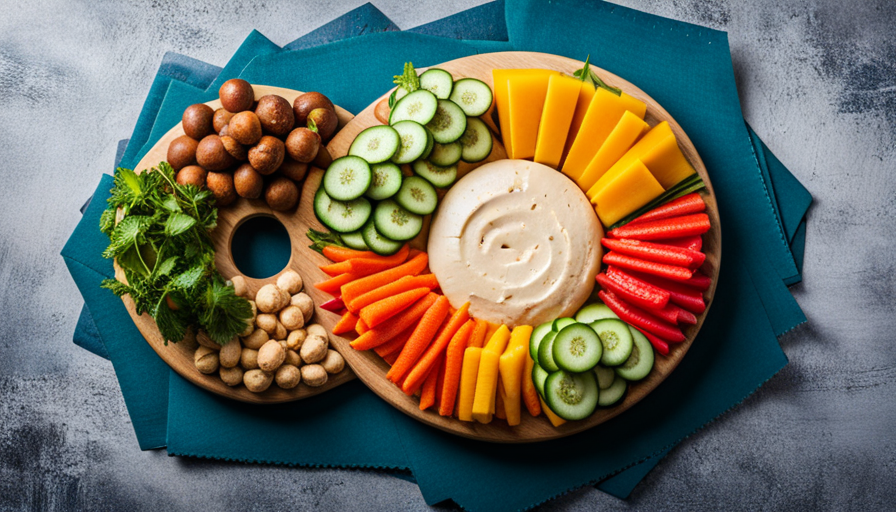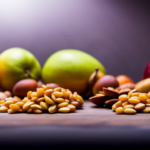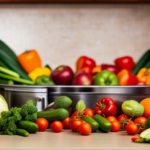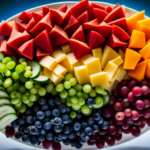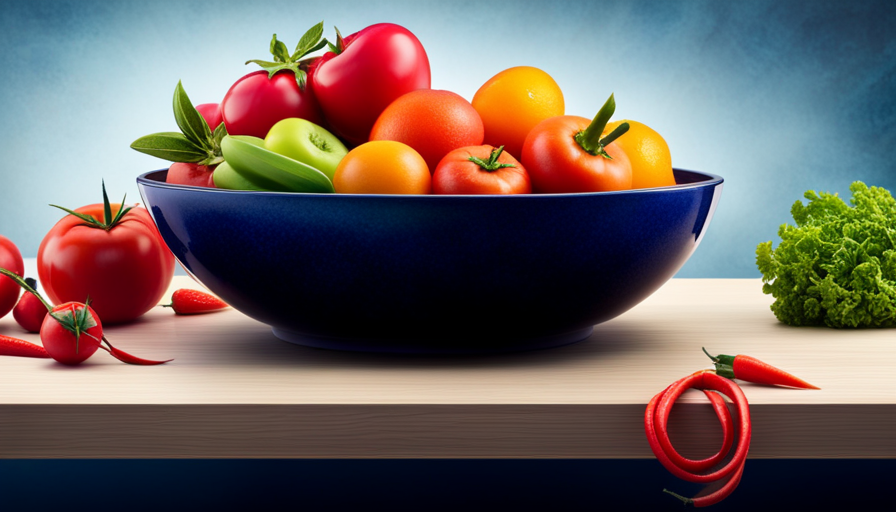Are you prepared to start a journey that will revolutionize your relationship with food?
Welcome to the world of the raw food diet, where vibrant colors, fresh flavors, and nourishing ingredients come together to create a truly transformative culinary experience.
Imagine a plate filled with an abundance of crisp, colorful vegetables, juicy fruits bursting with natural sweetness, and a variety of nuts, seeds, and sprouts that provide a delightful crunch.
This is not just a diet – it’s a lifestyle that celebrates the incredible power of raw, unprocessed foods.
As a registered dietitian, I am here to guide you through this exciting journey, providing evidence-based recommendations and guidelines to help you thrive on a raw food diet.
In this article, we will explore the various activities and practices that can enhance your raw food experience, from meal preparation and recipe experimentation to engaging in raw food workshops and retreats.
Let’s dive in and discover the endless possibilities that await you on your raw food journey.
Key Takeaways
- Experiment with new recipes to keep meals interesting and discover new favorite dishes
- Explore raw food restaurants, delivery services, farmers markets, and organic stores for convenient access to raw meals and fresh, organic produce
- Join raw food communities, support groups, and potlucks to share delicious raw food dishes and recipe ideas
- Enhance knowledge and skills in preparing raw food meals through workshops and classes, and consider creating a raw food garden for control over produce quality and freshness.
Meal Preparation and Recipe Experimentation
Get ready to have some fun in the kitchen as you whip up delicious and creative raw food meals while following this diet! Meal preparation is an essential part of the raw food diet, as it allows you to plan your meals in advance and ensure you’re getting all the necessary nutrients.
When preparing your meals, it’s important to focus on incorporating a variety of fruits, vegetables, nuts, and seeds to ensure you’re getting a wide range of nutrients. Meal planning can also help you stay organized and save time during the week.
Experimentation is another exciting aspect of the raw food diet. With so many raw food recipes available, you can get creative and try new combinations of flavors and textures. From zucchini noodles with avocado pesto to cashew cheese-stuffed mushrooms, the possibilities are endless. Not only does experimenting with new recipes keep your meals interesting, but it also allows you to discover new favorite dishes.
In addition to being fun and exciting, meal preparation and recipe experimentation on a raw food diet offer numerous nutritional benefits. Raw foods are packed with vitamins, minerals, and enzymes that can support optimal health and well-being. By consuming a variety of raw fruits and vegetables, you’re providing your body with essential nutrients that can boost your immune system, improve digestion, and increase energy levels.
As you become more comfortable with meal preparation and recipe experimentation, you may also find yourself wanting to explore new raw food restaurants. These establishments offer a wide range of delicious and nutritious options that can inspire you to continue your raw food journey.
Discovering New Raw Food Restaurants
Uncover exciting, new raw food restaurants to explore and tantalize your taste buds. When following a raw food diet, dining out can sometimes be a challenge. However, there are now an increasing number of raw food restaurants that cater to this specific dietary preference. These establishments offer a variety of delicious and nutritious raw dishes that showcase the natural flavors and textures of raw ingredients. To help you discover these hidden gems, consider utilizing raw food delivery services or raw food subscription boxes. These services can provide you with pre-prepared raw meals or ingredients, allowing you to enjoy restaurant-quality raw food in the comfort of your own home. Additionally, they can introduce you to new recipes and ingredients that you may not have considered before. To visualize the options available, take a look at the table below:
| Raw Food Delivery Services | Raw Food Subscription Boxes |
|---|---|
| Freshly prepared raw meals delivered to your doorstep | Curated selection of raw ingredients and recipes |
| Wide variety of menu options | Convenient and hassle-free meal planning |
| Customizable meal plans to suit your preferences | Discover new and unique raw food products |
| Easy and convenient online ordering | Expand your raw food recipe repertoire |
| Ensures access to nutritious raw meals even when dining out is not an option | Enhance your raw food culinary skills |
Exploring farmers markets and organic stores is another way to find fresh, raw ingredients to incorporate into your meals.
Exploring Farmers Markets and Organic Stores
Discover an array of fresh, organic produce and ingredients by exploring farmers markets and organic stores, ensuring a vibrant and nutritious culinary experience. When following a raw food diet, it’s important to prioritize the quality and sourcing of the foods we consume.
By visiting local farmers markets and participating in Community Supported Agriculture (CSA) programs, we can connect with local farmers and gain access to a wide variety of seasonal, organic produce.
One of the benefits of exploring farmers markets is the opportunity to learn about the benefits of organic farming and sustainable agriculture. Organic farming practices prioritize soil health, biodiversity, and the use of natural fertilizers and pest control methods. By supporting organic farmers, we contribute to the preservation of our environment and the reduction of pesticide exposure in our food.
Additionally, visiting farmers markets and organic stores allows us to discover unique and lesser-known fruits, vegetables, and ingredients that may not be readily available in traditional grocery stores. These local and organic options provide a rich source of vitamins, minerals, and antioxidants that contribute to our overall health and well-being.
By exploring farmers markets and organic stores, we can expand our knowledge of sustainable food systems and make informed choices that align with our values. This knowledge can also be valuable when joining raw food communities and support groups, where we can share experiences and exchange ideas about living a raw food lifestyle.
Joining Raw Food Communities and Support Groups
Immerse yourself in a vibrant community of like-minded individuals who share your passion for living a raw food lifestyle by joining raw food communities and support groups. These communities are a great way to connect with others who are also on a raw food diet, providing a sense of camaraderie and support.
One of the benefits of joining raw food communities is the opportunity to find raw food potlucks. These events allow you to share and enjoy delicious raw food dishes with others who appreciate and understand the importance of this lifestyle. It’s a chance to discover new recipes, exchange tips and tricks, and gain inspiration from fellow raw food enthusiasts.
Additionally, participating in raw food challenges is a common practice within these communities. These challenges often involve committing to a certain period of time where you consume only raw foods. It can be a fun and motivating way to stay on track with your raw food diet and push yourself to try new recipes and ingredients.
By engaging in raw food workshops and classes, you can further expand your knowledge and skills in preparing raw food meals. These educational opportunities provide hands-on experience, allowing you to learn new techniques and gain a deeper understanding of the health benefits associated with a raw food diet.
Transition: As you continue your exploration of the raw food lifestyle, another valuable step is engaging in raw food workshops and classes.
Engaging in Raw Food Workshops and Classes
Engaging in raw food workshops and classes can be an exciting opportunity to enhance your knowledge and skills in preparing delicious and nutritious meals. These educational experiences provide valuable insights into the principles and practices of a raw food diet.
By participating in workshops and classes, individuals can learn about the benefits and challenges of following a raw food diet. Raw food workshops and classes offer a wealth of information on the benefits of a raw food diet. Participants can learn about the abundance of nutrients found in raw fruits, vegetables, nuts, and seeds. They can also discover how raw foods can support optimal digestion, boost energy levels, and promote vibrant health. Furthermore, these educational experiences often provide practical tips and techniques for incorporating more raw foods into daily meals.
While a raw food diet can offer numerous benefits, it also presents its own set of challenges. Raw food workshops and classes address these challenges by providing guidance on meal planning, food preparation techniques, and overcoming common obstacles. Participants can learn how to ensure adequate nutrient intake, maintain variety in their diet, and navigate social situations that may not be conducive to raw food choices.
By attending raw food workshops and classes, individuals can gain the knowledge and skills necessary to thrive on a raw food diet. As they become more proficient in their understanding and application of raw food principles, they can further explore the idea of growing their own raw food garden.
Growing Your Own Raw Food Garden
To truly embrace the benefits and principles of a raw food lifestyle, consider nurturing your own vibrant and nourishing garden. Growing your own raw food garden not only allows you to have complete control over the quality and freshness of your produce, but it also provides a rewarding and fulfilling experience.
Garden maintenance is crucial to ensure the health and vitality of your plants. This includes watering regularly, providing adequate sunlight, and protecting your plants from pests and diseases. It’s also essential to practice organic gardening methods, avoiding the use of synthetic fertilizers and pesticides.
Harvesting techniques play a vital role in maximizing the nutritional value of your raw food. It’s important to pick your produce when it’s ripe and at its peak of freshness. This ensures that you’re getting the maximum amount of nutrients from your fruits and vegetables. Additionally, proper storage and handling techniques are crucial to preserve the nutrients and flavors of your harvest.
By growing and maintaining your own raw food garden, you can have a sustainable source of fresh and nutritious ingredients for your raw food diet. It allows you to connect with nature, appreciate the process of food cultivation, and enjoy the satisfaction of consuming food that you’ve grown yourself.
In the next section, we’ll explore the exciting world of trying different raw food techniques and equipment.
Trying Different Raw Food Techniques and Equipment
Discovering new raw food techniques and equipment opens up a world of culinary possibilities, allowing me to create vibrant and delicious dishes that showcase the natural flavors and textures of fresh, unprocessed ingredients. Here are some raw food techniques and equipment that can enhance your raw food journey:
-
Dehydrator: A dehydrator is a must-have tool for raw food enthusiasts. It uses low heat to remove moisture from fruits, vegetables, and nuts, preserving their nutrients and creating crispy textures. From kale chips to fruit leather, the dehydrator can transform simple ingredients into tasty snacks.
-
Spiralizer: This handy gadget can turn vegetables like zucchini, carrots, and cucumbers into noodles or ribbons, adding a fun twist to your raw food dishes. With a spiralizer, you can create raw pasta dishes, salads, and even vegetable-based wraps.
-
High-speed blender: A powerful blender is essential for making smoothies, soups, and sauces. It can easily blend fruits, vegetables, and nuts into creamy concoctions packed with nutrients. With a high-speed blender, you can whip up delicious and nutritious raw food creations in minutes.
By incorporating these raw food techniques and equipment into your culinary repertoire, you can elevate your raw food experience and enjoy a wide variety of delicious and nutritious dishes.
Next, let’s explore the importance of practicing mindful eating and food combining in a raw food diet.
Practicing Mindful Eating and Food Combining
When practicing mindful eating and food combining, it’s important to savor each bite and be aware of how different ingredients complement each other in your meals.
Mindful eating techniques involve paying close attention to the sensory experience of eating, including the taste, texture, and smell of food. By focusing on the present moment, you can fully enjoy your meal and become more in tune with your body’s hunger and fullness cues.
Food combining is a strategy that involves pairing certain foods together to optimize digestion and nutrient absorption. For example, combining leafy greens with healthy fats, like avocado or nuts, can enhance the absorption of fat-soluble vitamins. Additionally, combining plant-based sources of iron, such as lentils or spinach, with vitamin C-rich foods, like citrus fruits or bell peppers, can increase iron absorption.
The benefits of food combining include improved digestion, reduced bloating, and increased nutrient absorption. By combining foods properly, you can support your body’s natural digestive processes and promote overall gut health.
Transition: Exploring raw food retreats and wellness centers allows individuals to further immerse themselves in the raw food lifestyle and gain additional knowledge and support.
Exploring Raw Food Retreats and Wellness Centers
Immerse yourself in the raw food lifestyle and gain additional knowledge and support by exploring raw food retreats and wellness centers.
Raw food retreats offer a unique opportunity to fully engage with the raw food movement and connect with like-minded individuals. These retreats often provide a range of activities, including cooking classes, workshops, and lectures by experts in the field. By attending these retreats, you can learn new recipes, understand the benefits of raw food, and gain insights into maintaining a balanced raw food diet.
Wellness centers focused on raw food provide a supportive environment for individuals looking to adopt or maintain a raw food diet. These centers offer a variety of services, such as personalized consultations with nutritionists or dietitians, meal planning assistance, and access to high-quality raw food products. Additionally, wellness centers may have facilities for detoxification, such as saunas or flotation tanks, to aid in the cleansing process.
Exploring raw food retreats and wellness centers can be a valuable experience for those on a raw food diet. It offers an opportunity to deepen your understanding of raw food principles, connect with like-minded individuals, and receive professional guidance on maintaining a balanced diet. By immersing yourself in these environments, you can further enhance your raw food journey.
Transition: Once you’ve gained knowledge and support from raw food retreats and wellness centers, you may want to share your experiences with others.
Sharing Your Raw Food Journey on Social Media and Blogs
Sharing your raw food journey on social media and blogs can be a fun and inspiring way to connect with others who are also passionate about the raw food lifestyle. It provides a platform to share your experiences, recipes, and document your progress.
By sharing your raw food recipes, you can inspire others to try new dishes and explore the world of raw food cuisine.
Documenting your progress on social media and blogs allows you to track your journey and see how far you’ve come. It can also serve as a source of motivation and accountability. Others who are following your journey may find inspiration in your successes and challenges, and it can create a sense of community and support.
When sharing your raw food journey on social media and blogs, it’s important to provide accurate and evidence-based information. This could include sharing the nutritional benefits of certain raw food ingredients or explaining how certain cooking methods affect the nutrient content of food. By presenting factual information, you can educate and inform your audience about the raw food lifestyle.
Sharing your raw food journey on social media and blogs can be a powerful way to connect with others, inspire creativity in the kitchen, and document your progress. By providing informative and factual content, you can contribute to the raw food community and help others on their own journey towards a healthier lifestyle.
Frequently Asked Questions
How can I ensure I’m getting all the necessary nutrients on a raw food diet?
To ensure proper nutrient intake on a raw food diet, there are several key tips to keep in mind. First, focus on variety by including a wide range of fruits, vegetables, nuts, and seeds.
Secondly, make sure to consume enough protein sources such as sprouted legumes, nuts, and seeds.
Additionally, consider supplementing with vitamin B12, as it may be lacking in a raw food diet.
Lastly, consult with a registered dietitian or nutritionist to ensure you’re meeting your nutritional needs while following a raw food diet.
Can I still eat out at non-raw food restaurants while following a raw food diet?
While following a raw food diet, eating out at non-raw food restaurants can present some challenges. It may be difficult to find menu options that align with the requirements of a raw food diet, as many dishes are cooked or processed. It’s important to communicate your dietary needs to the restaurant staff and ask if they can accommodate your preferences. However, it’s recommended to plan ahead and bring your own raw food options to ensure you can stick to your diet.
Are there any specific precautions I should take when shopping for raw food at farmers markets and organic stores?
When shopping for raw food at farmers markets and organic stores, it’s important to take certain precautions.
First, ensure that the produce is fresh and free from any signs of spoilage.
Look for organic options, as they’re grown without the use of harmful pesticides and chemicals.
Additionally, wash all fruits and vegetables thoroughly before consuming to remove any potential contaminants.
Choosing organic raw food can provide numerous benefits, including higher nutrient content and lower exposure to pesticides.
How do I find local raw food communities and support groups in my area?
To find local raw food communities and support groups in your area, there are several steps you can take.
Start by searching online for raw food meetups, forums, or social media groups specific to your location.
Additionally, you can reach out to local health food stores, farmers markets, or organic stores to inquire about any raw food events or gatherings they may be aware of.
Lastly, consider contacting registered dietitians or nutritionists who specialize in raw food diets, as they may have connections or resources to share.
Are there any certifications or qualifications I should look for in raw food workshops and classes before signing up?
When looking for raw food workshops and classes, it’s important to consider certifications and qualifications. Look for instructors who’ve completed a recognized certification program in raw food preparation. Additionally, qualifications such as a culinary degree or experience in nutrition can provide a solid foundation for teaching raw food classes. These certifications and qualifications ensure that the instructor has the knowledge and expertise to provide accurate and evidence-based information to participants.
How Can I Incorporate More Variety into My Raw Food Diet?
Are you looking to add more excitement to your raw food diet? There are plenty of raw food diet options to explore. Consider adding a variety of fruits, vegetables, nuts, seeds, and superfoods to your meals. Experiment with different recipes and meal combinations to keep things interesting and satisfying.
Conclusion
In conclusion, following a raw food diet offers a variety of opportunities for exploration and self-discovery.
Through meal preparation and recipe experimentation, you can create delicious and nutritious raw meals.
By exploring raw food restaurants, farmers markets, and organic stores, you can discover new ingredients and support local businesses.
Joining raw food communities and attending workshops can provide valuable knowledge and support.
Trying different techniques and equipment can enhance the raw food experience.
Practicing mindful eating and sharing your journey on social media can foster a sense of connection.
Lastly, exploring retreats and wellness centers can provide a holistic approach to raw food living.
Embark on this raw food journey with an open mind and embrace the endless possibilities it offers.


